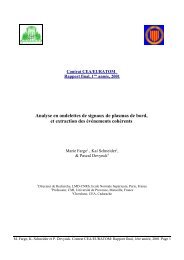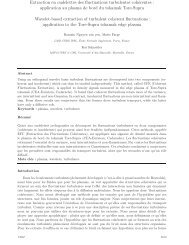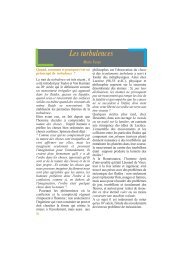wavelet transforms and their applications to turbulence - Wavelets ...
wavelet transforms and their applications to turbulence - Wavelets ...
wavelet transforms and their applications to turbulence - Wavelets ...
You also want an ePaper? Increase the reach of your titles
YUMPU automatically turns print PDFs into web optimized ePapers that Google loves.
Annual Reviewswww.annualreviews.org/aronlineWAVELET TRANSFORMS 397tions. Are there some elementary coherent structures? Do <strong>their</strong> mutualinteractions have a universal character? Is it possible <strong>to</strong> compute the flowevolution with a reduced number of degrees of freedom relative <strong>to</strong> the verylarge number of Fourier components otherwise necessary? This reductioncould correspond <strong>to</strong> a projection of Navier-S<strong>to</strong>kes equations on thosecoherent structures or on some related functional bases well localized inphysical space.Being very uncomfortable with these two separate descriptions of <strong>turbulence</strong>,I was immediately enthusiastic when, in 1984, A. Grossmann <strong>to</strong>ldme about the <strong>wavelet</strong> transform theory he was developing from Morlet’soriginal ideas. His theory had the promise of a unified approach whichcould reconcile these two descriptions <strong>and</strong> allow us <strong>to</strong> analyze a turbulentflow in terms of both space <strong>and</strong> scale at once, up <strong>to</strong> the limits of theuncertainty principle. Another reason, rather naive, for the immediateappeal of <strong>wavelet</strong>s was the fact that the Morlet <strong>wavelet</strong> evoked <strong>to</strong> me theshape of Tennekes <strong>and</strong> Lumley’s eddy (Tennekes & Lumley 1972) proposed<strong>to</strong> model <strong>turbulence</strong>, <strong>and</strong> of some coherent structures whose existencehad been conjectured by Ruelle (D. Ruelle, personal communication,1983) <strong>and</strong> then observed by Basdevant in his numerical simulations oftwo-dimensional flows (Basdevant & Couder 1986). Indeed, it seems muchbetter <strong>to</strong> decompose a turbulent field in<strong>to</strong> such localized oscillations offinite energy as <strong>wavelet</strong>s, rather than in<strong>to</strong> space-filling trigonometric functionswhich do not belong <strong>to</strong> the L2(II n) functional space <strong>and</strong> therefore arenot of finite energy.In the context of <strong>turbulence</strong>, the <strong>wavelet</strong> transform may yield someelegant decompositions of turbulent flows (Section 5.1). The continuous<strong>wavelet</strong> transform offers a continuous <strong>and</strong> redundant unfolding in termsof both space <strong>and</strong> scale, which may enable us <strong>to</strong> track the dynamics ofcoherent structures <strong>and</strong> measure <strong>their</strong> contributions <strong>to</strong> the energy spectrum(Section 5.2). The discrete <strong>wavelet</strong> transform allows an orthonormal projectionon a minimal number of independent modes which might be used<strong>to</strong> compute or model the turbulent flow dynamics in a better way thanwith Fourier modes (Section 5.3).2. WAVELET TRANSFORM PRINCIPLES2.1 His<strong>to</strong>ryThe <strong>wavelet</strong> transform originated in 1980 with Morlet, a French researchscientist working on seismic data analysis (Morlet 1981, 1983; Goupillaudet al 1984), who then collaborated with Grossmann, a theoretical physicistfrom the CNRS in Marseille-Luminy. They developed the geometricalformalism of the continuous <strong>wavelet</strong> transform (Grossmann et al 1985,





